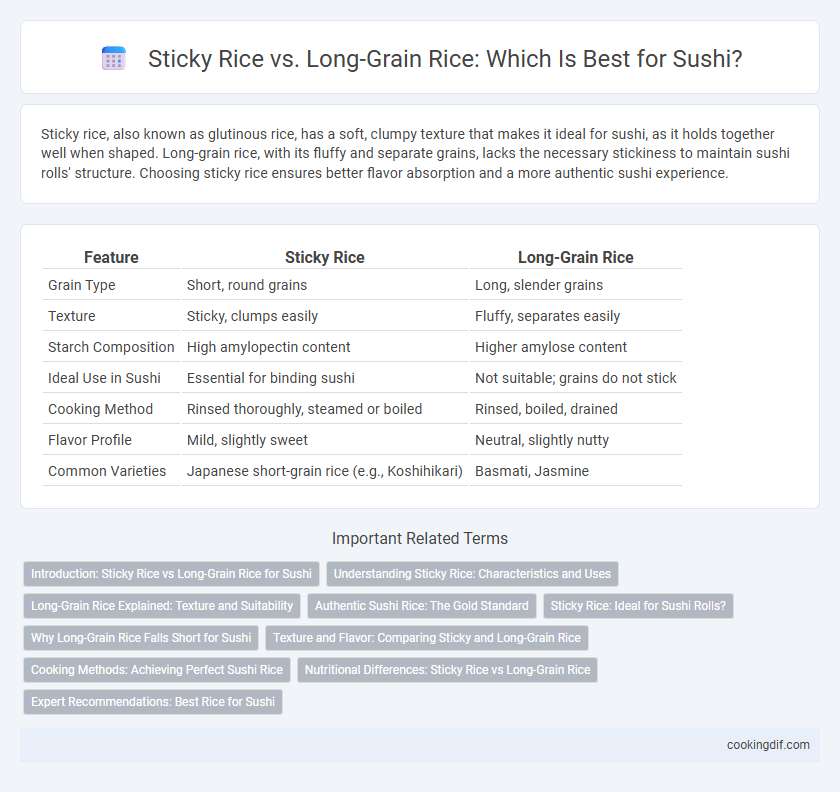Sticky rice, also known as glutinous rice, has a soft, clumpy texture that makes it ideal for sushi, as it holds together well when shaped. Long-grain rice, with its fluffy and separate grains, lacks the necessary stickiness to maintain sushi rolls' structure. Choosing sticky rice ensures better flavor absorption and a more authentic sushi experience.
Table of Comparison
| Feature | Sticky Rice | Long-Grain Rice |
|---|---|---|
| Grain Type | Short, round grains | Long, slender grains |
| Texture | Sticky, clumps easily | Fluffy, separates easily |
| Starch Composition | High amylopectin content | Higher amylose content |
| Ideal Use in Sushi | Essential for binding sushi | Not suitable; grains do not stick |
| Cooking Method | Rinsed thoroughly, steamed or boiled | Rinsed, boiled, drained |
| Flavor Profile | Mild, slightly sweet | Neutral, slightly nutty |
| Common Varieties | Japanese short-grain rice (e.g., Koshihikari) | Basmati, Jasmine |
Introduction: Sticky Rice vs Long-Grain Rice for Sushi
Sticky rice, also known as glutinous rice, is essential for authentic sushi due to its high amylopectin content that creates a cohesive texture, allowing the rice to hold together when forming sushi rolls. Long-grain rice, with a lower starch content and drier texture, lacks this stickiness, making it unsuitable for sushi as it fails to bond properly with other ingredients. The choice between sticky and long-grain rice directly impacts sushi's texture, flavor, and structural integrity.
Understanding Sticky Rice: Characteristics and Uses
Sticky rice, known for its high amylopectin content, has a glutinous texture that allows it to clump together, making it ideal for sushi. This short-grain rice variety absorbs water evenly, resulting in a chewy yet tender consistency essential for shaping sushi rolls and nigiri. Its unique starch composition differentiates it from long-grain rice, which remains separate and fluffy, unsuitable for sushi preparation.
Long-Grain Rice Explained: Texture and Suitability
Long-grain rice has a firm, dry texture with separate, elongated grains that do not clump together, making it unsuitable for traditional sushi which requires stickiness to hold shape. Unlike sticky rice, which is high in amylopectin content for its glutinous quality, long-grain varieties like Basmati or Jasmine are lower in amylopectin and higher in amylose, resulting in a fluffy, non-adhesive consistency. This texture difference impacts sushi preparation, as long-grain rice cannot properly bind the ingredients or form compact sushi rolls essential for authentic presentation and eating experience.
Authentic Sushi Rice: The Gold Standard
Authentic sushi rice is traditionally made from short-grain sticky rice, prized for its unique ability to absorb vinegar and retain a slightly sticky texture essential for molding sushi. Long-grain rice lacks the necessary starch content, resulting in a drier, fluffier consistency that fails to hold together properly. The sticky rice variety ensures the perfect balance of chewiness and cohesion, making it the gold standard for genuine sushi preparation.
Sticky Rice: Ideal for Sushi Rolls?
Sticky rice, also known as glutinous rice, is ideal for sushi rolls due to its high starch content, which provides the perfect adhesive texture to hold ingredients together. Unlike long-grain rice, its short, plump grains become soft and sticky when cooked, enhancing the structural integrity and mouthfeel of sushi. This characteristic makes sticky rice essential for authentic sushi preparation, ensuring the roll maintains its shape and delivers a cohesive eating experience.
Why Long-Grain Rice Falls Short for Sushi
Long-grain rice lacks the necessary starch content that sticky rice possesses, resulting in grains that separate easily and fail to adhere properly for sushi rolls. The lower amylopectin concentration in long-grain rice diminishes its stickiness, which is crucial for maintaining the structural integrity of sushi. Consequently, sticky rice varieties like japonica are preferred for authentic sushi due to their superior texture and cohesiveness.
Texture and Flavor: Comparing Sticky and Long-Grain Rice
Sticky rice offers a chewy, glutinous texture that clings well together, making it ideal for sushi rolls that require compactness and shape retention. Long-grain rice has a drier, fluffier texture with distinct grains, which tends to separate rather than stick, resulting in less cohesion for sushi applications. Flavor-wise, sticky rice has a subtly sweet and rich taste that complements vinegared sushi seasoning, while long-grain rice is milder and less suited to absorbing the classic sushi flavor profile.
Cooking Methods: Achieving Perfect Sushi Rice
Sticky rice, also known as short-grain rice, requires thorough rinsing and soaking before cooking to remove excess starch and ensure the grains stick together perfectly for sushi. Long-grain rice, such as Jasmine or Basmati, is less suitable for sushi because its grains remain separate and fluffy, lacking the necessary stickiness. Achieving perfect sushi rice involves precise water-to-rice ratios, steaming rather than boiling, and seasoning with a mixture of rice vinegar, sugar, and salt to create the ideal texture and flavor.
Nutritional Differences: Sticky Rice vs Long-Grain Rice
Sticky rice contains higher levels of amylopectin, making it more digestible and better suited for sushi due to its cohesive texture, while long-grain rice has a higher amylose content, resulting in a drier, fluffier grain. Nutritionally, sticky rice tends to have a slightly higher carbohydrate content and lower fiber than long-grain rice, influencing glycemic response and energy release. Vitamins and minerals such as manganese and magnesium are present in both, but the sticky rice's composition favors rapid energy absorption essential for sushi preparation.
Expert Recommendations: Best Rice for Sushi
Experts recommend using short-grain sticky rice for sushi due to its higher amylopectin content, which creates the ideal sticky texture essential for shaping sushi rolls. Long-grain rice, with its lower starch content and firmer, fluffier texture, is less suitable as it doesn't hold together well in sushi preparation. For authentic sushi, Japanese short-grain rice varieties like Koshihikari are preferred for their balance of stickiness and flavor.
Sticky rice vs Long-grain rice for sushi Infographic

 cookingdif.com
cookingdif.com